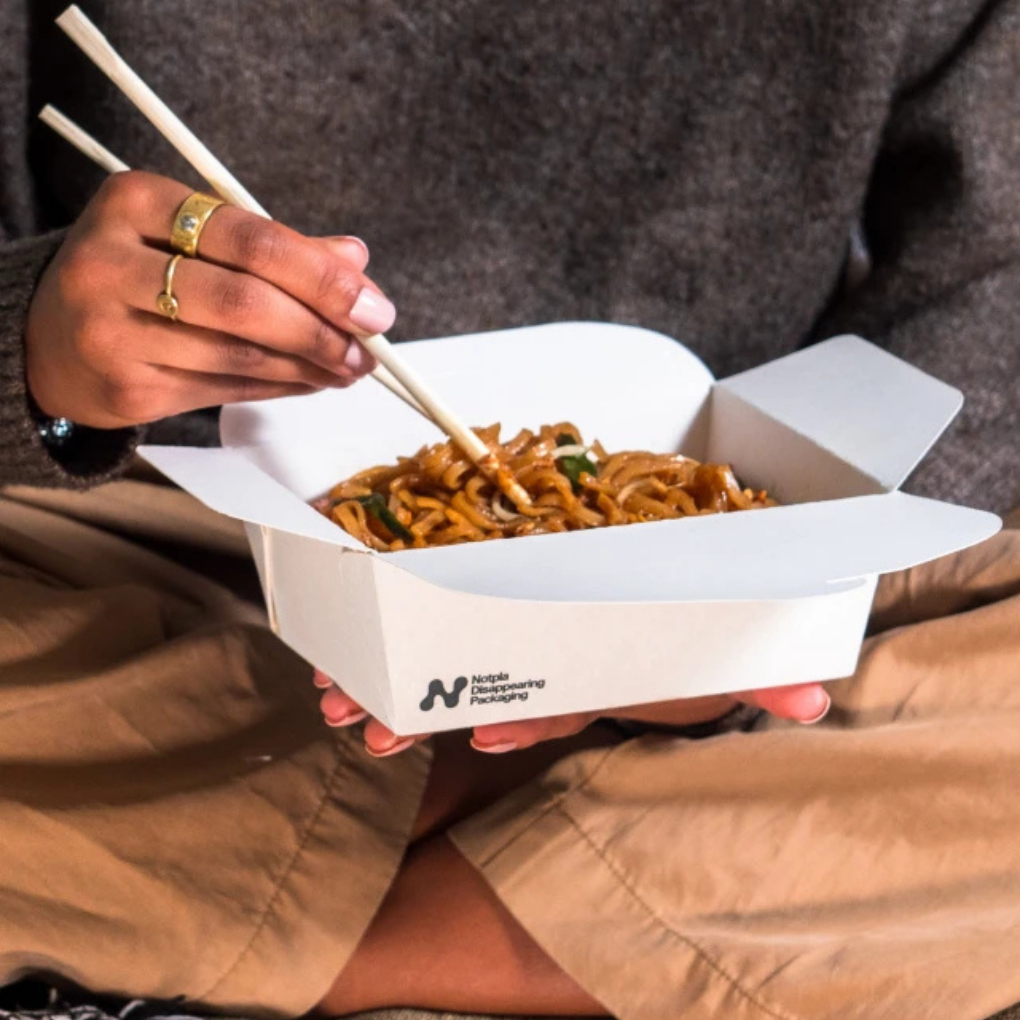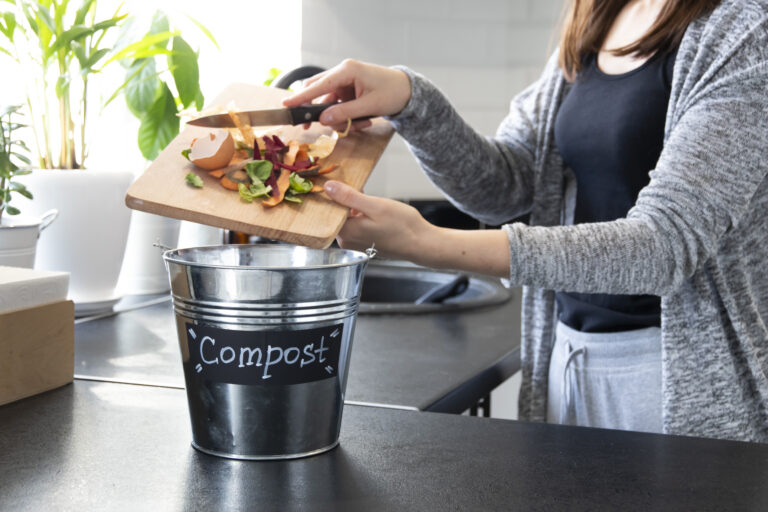
Key Takeaways
- Sustainable food packaging reduces waste and carbon emissions by using renewable, recyclable, and compostable materials instead of single-use plastics.
- Brands adopting eco-friendly packaging gain consumer trust and meet growing regulatory and market demands for environmental responsibility.
- Innovations like mushroom packaging, edible films, and reusable systems are shaping the future of low-waste food delivery and retail.
It’s hard to stomach, but if current trends continue, plastic could outweigh fish in our oceans by 2050. A big part of that problem? The food packaging industry. From single-use containers to multilayer snack wrappers, packaging is one of the most significant contributors to global plastic waste.
And before you think, “Well, I recycle,” here’s the kicker: most food packaging isn’t recyclable. Greasy pizza boxes, shiny chip bags, and that clingy plastic film covering leftovers often end up in landfills or the environment. Even materials labeled “compostable” can be misleading — they usually require industrial facilities that many communities don’t have access to.
But progress is happening. The shift toward sustainable food packaging is gaining momentum, powered by innovative materials and growing consumer demand for better options. And no, you don’t have to overhaul your entire kitchen to be part of the solution.
In this guide, we’ll explore what sustainable packaging really means, what materials and technologies are leading the way, and how these changes are reducing waste while creating healthier outcomes for people and the planet. Whether you’re packing school lunches, meal prepping for the week, or just tired of that drawer full of mismatched food storage containers, there’s something here for you.
What Is Sustainable Food Packaging?
Sustainable food packaging refers to materials and systems designed to minimize environmental impact throughout their entire life cycle — from production and use to disposal or reuse. The goal isn’t just to replace plastic, but to rethink how packaging is sourced, made, and recovered.
At its core, sustainable packaging prioritizes:
- Renewable or recycled materials that reduce reliance on virgin plastic and fossil fuels.
- Efficient design that uses less material overall while maintaining food safety and shelf life.
- End-of-life solutions like recycling, composting, or reusability to keep waste out of landfills and oceans.
Unlike traditional packaging, which often focuses solely on convenience and cost, sustainable options consider the full environmental footprint, including resource use, emissions, and the ability to integrate into a circular economy.
Why Sustainable Packaging Matters
Because packaging doesn’t just protect food, it shapes our entire waste system. Every year, the world produces hundreds of millions of tons of plastic packaging, much of which is used for only a few minutes before being discarded. According to the OECD, less than 10% of global plastic waste is actually recycled, meaning the vast majority ends up incinerated, landfilled, or leaking into the environment.
This is where sustainable food packaging makes a measurable difference. By using renewable, compostable, or recyclable materials, companies can reduce the carbon footprint of their products while reducing plastic pollution. Even small changes, such as switching from multilayer plastic pouches to paper or fiber-based containers, can dramatically reduce waste.
But the shift isn’t driven solely by environmental concerns. Consumers are demanding it. Recent market analyses show that more than 70% of shoppers prefer brands that prioritize sustainability in their packaging, even if it costs slightly more. For food and beverage companies, that means greener packaging isn’t just good ethics, it’s an innovative business.
Regulations are also catching up. Many countries are banning certain single-use plastics, mandating recycled content, or requiring Extended Producer Responsibility (EPR) programs that make manufacturers accountable for packaging waste. These policies are reshaping supply chains and rewarding early adopters who invest in innovation now.
Key Characteristics of Sustainable Food Packaging
A single material doesn’t define sustainable packaging — it’s about how all the pieces work together to reduce waste, conserve resources, and protect both people and the planet. Whether it’s a takeout box, yogurt cup, or shipping sleeve, the most sustainable options share a few common traits.
Renewable, Recyclable, or Compostable Materials
These materials come from resources that can be replenished, like paper, bamboo, or cornstarch, or can safely return to the environment through recycling or composting. Some packaging even blends multiple eco-friendly materials, such as recycled paper lined with plant-based films, to improve performance without adding plastic.
Lightweight and Low-Waste Design
The most sustainable packaging often uses less material to do the same job. By reducing layers, trimming excess, or redesigning shapes, companies cut down on production waste and shipping emissions. This process, called lightweighting, can minimize transport energy use by up to 30%.
Safe and Non-Toxic Composition
Food packaging should never leach harmful chemicals like BPA, PFAS, or phthalates. Sustainable alternatives use food-grade natural coatings, water-based inks, or bio-resins made from sugarcane and seaweed. These choices keep food safer and prevent microplastic contamination.
Designed for a Circular Economy
Truly sustainable packaging is built with its entire life cycle in mind — from responsible sourcing and manufacturing to reuse, recycling, or composting. This approach supports a circular system in which materials stay in use longer rather than being discarded after a single use.
Brands use life-cycle analysis (LCA) to measure their environmental impact and identify ways to reduce waste at every stage. Refillable jars, deposit-return coffee cups, and packaging-as-a-service programs are all real-world examples of how this closed-loop model works in practice.
Learn More: How to Tell If Plastic Is BPA-Free Wondering how to spot safer materials? Learn how to identify BPA-free plastics and which alternatives are best for your health and the planet. Read more💡 what it means
Life-Cycle Analysis

Ever wonder how brands figure out which packaging is truly “eco-friendly”? That’s where Life Cycle Assessment (LCA) comes in. It’s a scientific method that measures a product’s total environmental impact — from raw materials and manufacturing to shipping, use, and disposal.
For packaging, an LCA helps uncover hidden trade-offs. For example, a lightweight plastic pouch might use less energy to produce than a heavier glass jar, but it could create more waste at the end of its life. The goal is to find the balance where performance, cost, and environmental responsibility meet.
To learn more, explore the U.S. Department of Energy’s Introduction to Life Cycle Assessment (LCA), a helpful overview of how LCAs guide more innovative design and sustainability decisions.
Types of Sustainable Food Packaging
There’s no single “perfect” material when it comes to sustainability. What works for a frozen meal might not suit fresh produce or a coffee cup. That’s why the most effective packaging systems use a combination of solutions, each chosen for its environmental impact, food safety, and practicality.
| Material Type | Source | Key Benefits | Best Uses |
|---|---|---|---|
| Bioplastics (PLA, PHA) | Corn, cassava, sugarcane-based ethanol | Renewable, compostable, lower carbon footprint compared to petroleum plastics | Takeout containers, cutlery, films |
| Plant & Fiber-Based Packaging | Paper, bamboo, hemp, bagasse (sugarcane fiber), mycelium (mushroom root) | Renewable, compostable, minimal toxins, can replace polystyrene foam | Plates, cups, trays, protective inserts, wraps |
| Recycled (PCR) Materials | Post-consumer plastic, aluminum, paper | Reduces landfill waste, conserves resources, supports circular economy | Bottles, jars, outer packaging |
| Compostable & Biodegradable | Cellulose, cornstarch, plant fibers | Breaks down safely in compost systems, reduces microplastic pollution | Food wraps, utensils, flexible films |
| Reusable Systems | Glass, stainless steel, silicone | Eliminates single use, durable, long lifespan, cost-effective over time | Refill containers, jars, takeout programs |
From compostable coffee lids to glass refill jars, each option helps reduce our packaging footprint. What’s exciting is how fast innovation is happening — bioplastics are getting stronger, fiber materials are replacing clamshells, and reusable systems are finally scaling beyond niche markets.
Emerging Trends and Innovations

Sustainable food packaging is changing fast. New materials and more innovative designs are making it easier for brands and all of us to cut waste without giving up convenience. These ideas show that packaging can protect our food and the planet simultaneously.
Edible Packaging
Imagine eating your snack and the wrapper, too. Edible packaging makes that possible. It’s made from things like seaweed, rice starch, and potatoes, and it naturally dissolves or can even be eaten. Some companies are already using it for sauces, snacks, and single-serve drinks. A U.K. company called Notpla makes seaweed-based packets that biodegrade in just a few weeks — no compost bin or recycling needed.
Mushroom-Based (Mycelium) Packaging
This one’s as cool as it sounds. Mycelium, the root structure of mushrooms, can be grown into sturdy, lightweight shapes that replace Styrofoam and plastic packaging. It’s made from farm byproducts like corn husks or hemp fibers and breaks down in about a month under composting conditions. Companies like Ecovative and Mushroom® Packaging are already using it to pack electronics, cosmetics, and food, proving that mushrooms can do a lot more than sit on your pizza.
Advanced Compostable Films
You’ve probably seen the thin plastic film that seals sandwiches or wraps produce. New versions made from plant cellulose and PHA work just as well but break down naturally in compost systems. They help food stay fresh, resist moisture, and can be applied to existing packaging machines, so companies don’t need to buy new equipment. That makes switching to compostable films easier and more affordable.
Brands like NatureFlex™ by Futamura are leading the way with flexible, plant-based films that perform like traditional plastic while safely returning to the environment after use.
Flexible and Minimalist Packaging
When it comes to packaging, less really is more. Brands are now cutting back on extra layers, skipping shiny coatings, and using a single material to make recycling easier. Some are even adding QR codes or digital labels so you can scan and learn how to recycle the package correctly. These simple design changes reduce waste, save money, and make packaging more straightforward to process after use.
Benefits of Sustainable Food Packaging
Switching to sustainable food packaging isn’t just about being “eco-friendly.” It’s about paying attention to where our materials come from and where they end up. Every wrapper, lid, or box has a life cycle, and the choices we make along the way can either protect or pollute the planet.
For businesses, that shift often sparks new ideas and builds absolute trust with customers. For the rest of us, it’s a reminder that the small things — like how we pack our lunch — can have a much bigger impact than we think.
🌎 Environmental Benefits
Sustainable packaging helps reduce waste, lower carbon emissions, and conserve natural resources. Choosing recyclable, compostable, or reusable materials keeps tons of plastic out of landfills and oceans each year. These smarter choices protect wildlife, preserve ecosystems, and help limit the spread of microplastics in our food and water.
🤝 Brand Trust and Reputation
Today’s shoppers notice what companies do — not just what they say. When a brand uses eco-friendly packaging, it signals transparency and care. People are more likely to support companies that take responsibility for their impact. Over time, that trust builds loyalty and strengthens a brand’s reputation far more than flashy marketing ever could.
💰 Cost and Operational Savings
While switching to new materials can feel expensive at first, it often saves money in the long run. Lighter packaging lowers shipping costs. Reusable or refill systems reduce the need to restock supplies constantly. As demand grows, prices for sustainable materials continue to decline, making them a wise long-term investment for businesses of all sizes.
⚙️ Innovation and Future Readiness
Sustainability drives creativity. Brands that start making changes now are better prepared for new regulations, shifting customer values, and resource shortages ahead. The companies experimenting with better materials today will be the ones leading tomorrow, proving that innovation and responsibility can go hand in hand.
At its core, sustainable packaging is about finding balance between what works for people, businesses, and the planet. It’s a shift that makes sense on every level: it cuts waste, builds trust, and opens the door to better design. When companies start thinking this way, packaging becomes more than just a container — it becomes part of the solution.
Challenges and Considerations
Switching to sustainable packaging isn’t always simple. New materials can cost more, perform differently, or need remarkable recycling or composting systems that aren’t available everywhere. And while many people want eco-friendly options, not everyone knows how to dispose of them correctly.
Still, these challenges are being worked through every day. As technology improves and more people choose better options, sustainable packaging is becoming easier to find, use, and recycle, closing the gap between good intentions and real impact.
For consumers, the best approach is to start small and stay curious. Look for items with clear recycling or composting labels, choose products in recyclable or refillable containers, and support companies that are transparent about their materials. Even simple steps like reusing jars or scanning a QR code for disposal info help push the packaging industry in a better direction.
Don’t Miss: The Truth About Plastic 👉 Want to take your sustainable packaging efforts even further? Learn why it’s so important to reduce plastic and how small changes can make a lasting impact. Read more →FAQs on Sustainable Food Packaging
Sustainable packaging is made from materials that can be reused, recycled, or composted without harming the environment. It also takes less energy and fewer resources to produce, helping reduce overall pollution and waste.
Not always. Compostable packaging only breaks down in the right conditions — usually in a commercial composting facility. If it ends up in a landfill, it may not decompose any faster than regular plastic. It’s most effective when composting systems are available in your area.
Glass, stainless steel, and certified BPA-free plastics are top choices for reusable packaging. For single-use items, look for compostable, recyclable, or PFAS-free labels.
Check for recycling symbols, numbers, or clear disposal instructions on the label. Some products now include QR codes that explain how and where to recycle. When in doubt, visit your city’s recycling guide — rules vary by location.
Final Thoughts on Sustainable Food Packaging
Sustainable food packaging isn’t just about replacing plastic with something new — it’s about changing how we think about waste in the first place.
The shift is already underway. New materials are being created, recycling programs are improving, and more people are paying attention to what happens after we throw something away. Real change doesn’t happen overnight, but it starts with small, consistent choices from companies designing packaging to people choosing what to buy.
📚 References
- Notpla. (n.d.). Notpla: Made from seaweed and plants, naturally biodegradable packaging. Retrieved October 28, 2025, from https://www.notpla.com/
- Organisation for Economic Co-operation and Development. (2022, February 22). Plastic pollution is growing relentlessly as waste management and recycling fall short. https://www.oecd.org/en/about/news/press-releases/2022/02/plastic-pollution-is-growing-relentlessly-as-waste-management-and-recycling-fall-short.html
- Packaging Gateway. (2024, May 7). The rise of bioplastics and new materials in sustainable packaging. https://www.packaging-gateway.com/features/the-rise-of-bioplastics-and-new-materials-in-sustainable-packaging
- U.S. Department of Energy. (2022, July 14). Introduction to life cycle assessment (LCA) [Slides and transcript]. https://www.energy.gov/sites/default/files/2022-07/2022-07-14%20-%20Intro%20to%20LCA%20-%20Slides%20and%20Transcript_compliant_0.pdf
- WWF. (n.d.). Will there be more plastic than fish in the sea? WWF UK. https://www.wwf.org.uk/myfootprint/challenges/will-there-be-more-plastic-fish-sea





